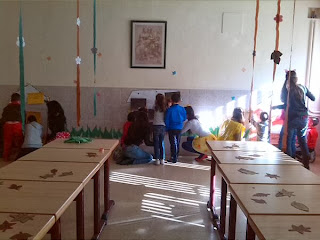WHY NOT?
.jpg) In my opinion, it is an effective resource that
we can use to teach in a classroom. They are useful to many things such as
building language or reinforce comprehension skills. All of this by using High Order
Thinking Skill which usually we do not know how to work them. There are many
different activities where learners can develop tools to understand unfamiliar
vocabulary, analyze characters or create their own dramatic texts. The thing is
that through theatre pupils actually learn and are involved while having a good
time.
In my opinion, it is an effective resource that
we can use to teach in a classroom. They are useful to many things such as
building language or reinforce comprehension skills. All of this by using High Order
Thinking Skill which usually we do not know how to work them. There are many
different activities where learners can develop tools to understand unfamiliar
vocabulary, analyze characters or create their own dramatic texts. The thing is
that through theatre pupils actually learn and are involved while having a good
time. Moreover, it is a fantastic way to work with
multiple intelligences. Don’t you think so? For instances, students are working
with kinesthetic intelligence and also with interpersonal and intrapersonal.
Even if they are working in groups they also have to reflect themselves first.
In addition, they definitely also work with musical/rhythm intelligence and
visual/spatial as well. Of course, the also work with linguistic intelligence
since speak, read and if the activity requires so, make questions too.
Moreover, it is a fantastic way to work with
multiple intelligences. Don’t you think so? For instances, students are working
with kinesthetic intelligence and also with interpersonal and intrapersonal.
Even if they are working in groups they also have to reflect themselves first.
In addition, they definitely also work with musical/rhythm intelligence and
visual/spatial as well. Of course, the also work with linguistic intelligence
since speak, read and if the activity requires so, make questions too.
Theatre, is also very easily adapted to any
topic. We can work any subject we want to but the smart thing would be to work
those that are more difficult to learn by our students. For example, we can
work History or Science. We can give them a text and have a group to represent
it. After it, the rest of the class could formulate questions about the action
watched and at the end, they will learn a Science or a History topic in a fun
and active way.
The other day, we had our last practical
lessons. Some of the activities were about theatre and they were fantastic. I
had so much fun and they were very meaningful for learning process as future
primary teachers. Don’t you agree with me? We learnt many different ways to
work difficult texts or boring topics in a way that is entertaining for
children, which make the teaching-learning process more effective and
successful.
To end, I would like to share with you my
opinion about this subject. I think it has been one of the most important that
we have had along our degree. Apart from the good times I have had during the
lessons, I have learnt a huge variety of resources and tools that I will be
able to use in a future. I would like to thank you all, for your collaboration
to let this happens and to Raquel for teaching us in such an involved way.





.jpg)
.jpg)
.jpg)

